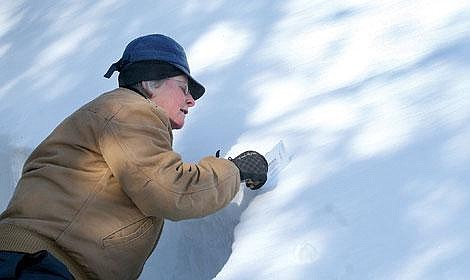Forest Service keeps up on avalanche data
The hundreds of backcountry skiers, snowboarders, snowmobilers and hikers that enjoy the excellent snow and beautiful scenery that the Lookout Pass area has to offer, rely heavily on online avalanche information. For that, they have two Forest Service employees to thank.
Carole Johnson, a staff member at the Superior Ranger District, meets up every Thursday with Idaho Ranger Dan Frigard to study the snow pack in the backcountry area in and around Lookout Pass.
"You should never venture into the backcountry without knowing about the existing conditions," Johnson said.
The information they gather goes to a larger database that covers avalanches all over the country and is available for backcountry recreationalists before the weekend begins.
In order to test the likelihood of an avalanche, Johnson and Frigard dig a snow pit to observe the layers of the snow.
Johnson said that the most important part of a snow pit, is where they dig it. Most avalanches occur on slopes that are between 35 and 45 degrees steep.
"Unfortunately, those are the best slopes to recreate on," said Johnson.
Snow pits need to be dug on a representative slope, or else the information they get from it is not very accurate. They also should not be dug in a dangerous place; the trick is finding a safe place with a similar slope pattern, Johnson said.
Once a snow pit has been dug, a lot can be determined about the likelihood of an avalanche, Johnson said. From the snow pit, they can see most of the layers of the snow that can be affected by recreationalists, and from these layers, the danger of an avalanche can be determined.
Certain formations of snow can be much more dangerous than others. According to Johnson, one of the most dangerous layers is called hoar frost. This is a feathery, crystallized frost that develops on cold clear nights. When this layer is on top of the snow, it is quite beautiful, and not at all bad to recreate on. However, if this layer is not removed by wind or other means before another snowfall, it can be very dangerous. With another layer on top of it, hoar frost becomes very unstable and allows snow to slip off the slope, causing an avalanche.
"Wind deposited snow is very unstable," Johnson said.
Much like hoar frost, snow deposited by wind does not provide a firm grip on the slope, and may lead to an avalanche when loaded with another layer of snow.
A heavy, wet, top layer of snow can make both wind deposited snow as well as hoarfrost even more likely to cause an avalanche.
"Avalanches are most likely to occur during or after a storm because the snow has not had a chance to adjust itself," Johnson said.
After they have recorded every layer of snow and its depths, Johnson and Frigard perform a few tests to get a better idea of snow stabilization.
First, they isolate several columns of snow with a snow saw. These columns allow them to perform several tests. In the shovel shear test, a shovel is inserted into the snow behind the column and they measure how much pressure it takes to pull the column down. They also perform a compression test, where the shovel is placed flat on top of the column and compressed at different strengths to see how much pressure it takes to cause a break in the column.
Johnson said that these tests are designed to simulate the types of stress that are put on the slope by recreationalists.
The final test they perform on the snow pit involves a wide column around the width of a ski or snowboard. After this column has been cut out of the wall of the snow pit, Frigard stands on top of it and jumps up and down with steadily growing force to see how much force it takes to break off the column.
"This is my favorite test," laughed Frigard.
All of the results from the tests are recorded and later used to determine a likelihood of avalanche in the area.
According to Johnson, just knowing the conditions is not enough to be prepared for avalanches in the backcountry. Recreationalists need to have the proper equipment and training, also.
Johnson said that all backcountry recreationalists need to have a shovel, a probe poll, and an avalanche transceiver, and know how to use them.
"After a person has been buried under the snow for more than 30 minutes, the odds of finding them alive decrease drastically," Johnson said.
If someone is buried in an avalanche, their partner is the most likely person to rescue them. They do this by using transceivers to find the general area where a person is buried, then sticking a probe poll into the snow to find their exact location.
Johnson gives avalanche demonstrations and talks with any group that is interested. To schedule an avalanche talk, contact the Lolo National Forest Office at (406)329-3750.
For information on current avalanche conditions, visit www.avalanche.org.

